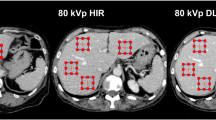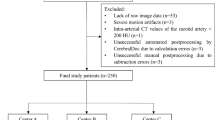Abstract
The purpose of this study was to evaluate the influence of different peripheral vein catheter sizes on the injection pressure, flow rate, injection duration, and intravascular contrast enhancement. A flow phantom with a low-pressure venous compartment and a high-pressure arterial compartment simulating physiological circulation parameters was used. High-iodine-concentration contrast medium (370 mg iodine/ml; Ultravist 370) was administered in the venous compartment through peripheral vein catheters of different sizes (14, 16, 18, 20, 22, and 24 G) using a double-head power injector with a pressure limit of 325 psi. The flow rate was set to 5 ml/s, with a total iodine load of 36 g for all protocols. Serial CT scans at the level of the pulmonary artery and the ascending and the descending aorta replica were obtained. The true injection flow rate, injection pressure, injection duration, true contrast material volume, and pressure in the phantom during and after injection were continuously monitored. Time enhancement curves were computed and both pulmonary and aortic peak time and peak enhancement were determined. Using peripheral vein catheters with sizes of 14–20 G, flow rates of approximately 5 ml/s were obtained. During injection through a 22-G catheter the pressure limit was reached and the flow rate was decreased, with a consecutive decreased pulmonary and aortic contrast enhancement compared to the 14- to 20-G catheters. Injection through a 24-G peripheral vein catheter was not possible because of disconnection of the canula due to the high flow rate and pressure. In summary, intravenous catheters with sizes of 14–20 G are suitable for CT angiography using an injection protocol with a high flow rate and a high-iodine-concentration contrast medium.


Similar content being viewed by others
References
Oliver JH 3rd, Baron RL (1996) Helical biphasic contrast-enhanced CT of the liver: technique, indications, interpretation, and pitfalls. Radiology 201:1–14
Silverman PM, Kohan L, Ducic I et al (1998) Imaging of the liver with helical CT: a survey of scanning techniques. AJR 170:149–152
Miles SG, Rasmussen JF, Litwiller T et al (1990) Safe use of an intravenous power injector for CT: experience and protocol. Radiology 176:69–70
Shuman WP, Adam JL, Schoenecker SA et al (1986) Use of a power injector during dynamic computed tomography. J Comput Assist Tomogr 10:1000–1002
Hingorani A, Ascher E, Marks N et al (2007) Comparison of computed tomography angiography to contrast arteriography for patients undergoing evaluation for lower extremity revascularization. Vasc Endovascular Surg 41:115–119
Goss JE, Ramo BW, Raff GL et al (1989) Power injection of contrast media during percutaneous transluminal coronary artery angioplasty. Cathet Cardiovasc Diagn 16:195–198
Ireland MA, Davis MJ, Hockings BE et al (1989) Safety and convenience of a mechanical injector pump for coronary angiography. Cathet Cardiovasc Diagn 16:199–201
Farres MT, Lammer J, Schima W et al (1996) Spiral computed tomographic angiography of the renal arteries: a prospective comparison with intravenous and intraarterial digital subtraction angiography. CardioVasc Interv Radiol 19:101–106
Cavagna E, D’Andrea P, Schiavon F et al (2000) Failing hemodialysis arteriovenous fistula and percutaneous treatment: imaging with CT, MRI and digital subtraction angiography. CardioVasc Interv Radiol 23:262–265
Fleischmann D (2003) Use of high concentration contrast media: principles and rationale-vascular district. Eur J Radiol 45(Suppl 1):S88–S93
Fleischmann D (2003) High-concentration contrast media in MDCT angiography: principles and rationale. Eur Radiol 13(Suppl 3):N39–N43
Schoellnast H, Brader P, Oberdabernig B et al (2005) High-concentration contrast media in multiphasic abdominal multidetector-row computed tomography: effect of increased iodine flow rate on parenchymal and vascular enhancement. J Comput Assist Tomogr 29:582–587
Herts BR, Cohen MA, McInroy B et al (1996) Power injection of intravenous contrast material through central venous catheters for CT: in vitro evaluation. Radiology 200:731–735
Knopp M, Kauczor HU, Knopp MA et al (1995) [Effects of viscosity, cannula size and temperature in mechanical contrast media administration in CT and magnetic resonance tomography]. Rofo 163:259–264
Knollmann F, Schimpf K, Felix R (2004) [Iodine delivery rate of different concentrations of iodine-containing contrast agents with rapid injection]. Rofo 176:880–884
Schoellnast H, Deutschmann HA, Fritz GA et al (2005) MDCT angiography of the pulmonary arteries: influence of iodine flow concentration on vessel attenuation and visualization. AJR 184:1935–1939
Cademartiri F, de Monye C, Pugliese F et al (2006) High iodine concentration contrast material for noninvasive multislice computed tomography coronary angiography: iopromide 370 versus iomeprol 400. Invest Radiol 41:349–353
Rist C, Nikolaou K, Kirchin MA et al (2006) Contrast bolus optimization for cardiac 16-slice computed tomography: comparison of contrast medium formulations containing 300 and 400 milligrams of iodine per milliliter. Invest Radiol 41:460–467
Schoellnast H, Deutschmann HA, Berghold A et al (2006) MDCT angiography of the pulmonary arteries: influence of body weight, body mass index, and scan length on arterial enhancement at different iodine flow rates. AJR 187:1074–1078
Author information
Authors and Affiliations
Corresponding author
Rights and permissions
About this article
Cite this article
Behrendt, F.F., Bruners, P., Keil, S. et al. Impact of Different Vein Catheter Sizes for Mechanical Power Injection in CT: In Vitro Evaluation with Use of a Circulation Phantom. Cardiovasc Intervent Radiol 32, 25–31 (2009). https://doi.org/10.1007/s00270-008-9359-8
Received:
Accepted:
Published:
Issue Date:
DOI: https://doi.org/10.1007/s00270-008-9359-8




